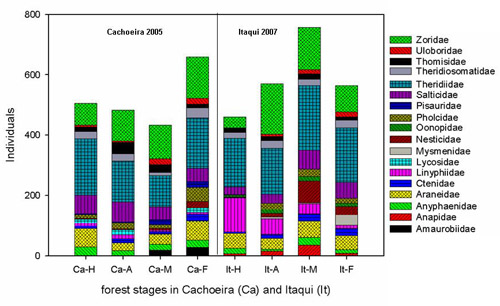Resutls
Using three methods we collected a total of 11845 Individuals of 46 families of which 40.7 (4822 individuals) were adults.
On the family level already a general view on the spider diversity in the Mata Atlântica can be drawn from this study. However, only the further detailed analysis on the morphospecies level can lead to reliable conclusions about the state of spider diversity in secondary forests of the southern Mata Atlantica. The Zoridae and Theridiidae in both Cachoeira and Itaqui are dominant families throughout all forest succession stages. In Itaqui Linyphiidae show a decrease from the young to the old stages, thus they could be used as a separating taxon between younger and older secondary forests.

Family distribution of spiders
The older forest stages M and F showed the highest family diversity Indices and family numbers both in Itaqui and Cachoeira (Tab.01 & Tab.02). There are significant differences in spider family diversity between young stages (H/A) and old stages (M/F). This can lead to the conclusion that as well on the species level there could be a higher spider diversity and species richness in older secondary forests, so that the family diversity could serve as a surrogate for lower taxon level diversity but this has to be tested by further analysis on the (morpho-)species level.
Table 1. diversity values Cachoeira 2005
| Cachoeira 05 | Taxa | Individuals | Shannon | Evenness |
| herbaceous H | 23 | 547 | 2,268 | 0,420 |
| young arboreal A | 24 | 515 | 2,362 | 0,442 |
| median M | 30 | 491 | 2,591 | 0,445 |
| old growth forest F | 31 | 716 | 2,594 | 0,432 |
Table 2. diversity values Itaqui 2007
| Itaqui 07 | Taxa | Individuals | Shannon | Evenness |
| herbaceous H | 27 | 527 | 2,317 | 0,376 |
| young arboreal A | 25 | 598 | 2,302 | 0,399 |
| median M | 31 | 822 | 2,559 | 0,417 |
| old growth forest F | 28 | 607 | 2,508 | 0,439 |
On the morphospecies level we found out that some Lycosidae species have a high potential to serve as indicators to distinguish younger from older stages. However whether this distribution patterns have their reason in the age structure of the forests and whether this conclusion can be generalized for the rest of the spider family assemblages can only be assured by the further determination to better determination levels and assured by accomplishing further multivariate analysis.